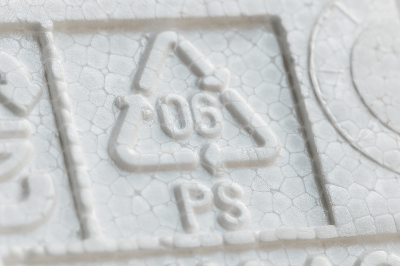What Is Polystyrene?

Polystyrene is a polymer compound obtained by polymerizing styrene, which is chemically synthesized from crude oil or naphtha.
It is also known as polystyrene or styrene resin. Polystyrene was first industrialized in Germany in the 1930s. It was later industrialized in the U.S., but production stalled for a while because the country was in the midst of World War II.
Full-scale production began after the war when Japan began importing styrene monomer in 1957.
Uses of Polystyrene
Polystyrene are versatile plastic that can be used for various applications, including plastic parts inside home appliances, food packaging materials, letter cases, computer housings, CD cases, ballpoint pen shafts, and other items requiring high transparency and rigidity. It is also used for diffusion plates and light guide plates for LCD displays. The applications are wide-ranging.
Foamed polystyrene, to which a foaming agent is added, can be easily formed during the molding process and is used in products that take advantage of its heat-insulating properties. It is used for cup noodle containers, containers for boxed lunches and prepared foods at supermarkets, as well as insulation materials for building materials.
Types of Polystyrene
Types of polystyrene include general polystyrene, expanded polystyrene, impact-resistant polystyrene, and biaxially oriented polystyrene sheet.
1. General-Use Polystyrene
General-use polystyrene is made exclusively from styrene, is inexpensive, and is used in many applications due to its well-balanced physical properties. It has excellent transparency, and good dimensional accuracy, and can be easily colored. Since styrene is the only raw material, it is easy to recycle.
On the other hand, it has weaknesses such as a low heat resistance temperature of 60-80°C, low-impact resistance, and high resistance to acids and alkalis, but low oil resistance.
2. Foamed Polystyrene
Expanded polystyrene is a material that foams and expands when heated during the molding process of the final product. It is more commonly known as expanded polystyrene. When polystyrene is manufactured, a foaming agent is added to the raw material, which causes it to expand when heated during the molding process. Since it is a foaming material, it has high heat insulation properties and is lightweight, making it widely used in everything from daily necessities to building materials.
3. Impact-Resistant Polystyrene
Impact-resistant polystyrene is made by adding rubber components such as polybutadiene during the polymerization of polystyrene, thereby improving the impact resistance of general-use polystyrene. While the impact resistance is 5 to 10 times higher than that of general-purpose polystyrene, there are disadvantages, such as lower rigidity and transparency. Moldability and chemical resistance are equivalent to those of general polystyrene.
Blends of this impact-resistant polystyrene with general-use polystyrene exhibit properties intermediate between these two, and a wide variety of grades are available.
4. Biaxially Oriented Polystyrene Sheet
A biaxially oriented polystyrene sheet is obtained by further stretching the extruded polystyrene sheet in two axial directions. Biaxial stretching results in molecular orientation, which improves strength and impact resistance without compromising transparency and chemical resistance. It is mainly used as a food packaging material, such as transparent lids for boxed lunches sold in supermarkets and convenience stores.
Other Information on Polystyrene
How Polystyrene Is Manufactured
Polystyrene can be produced industrially through bulk polymerization, solution polymerization, emulsion polymerization, and suspension polymerization. Styrene, the raw material, is obtained by thermal synthesis of benzene and ethylene.
1. Mass Polymerization Method
This is a method in which styrene monomer is polymerized by adding an initiator to the monomer and heating it as it is.
2. Solution Polymerization Method
This method involves dissolving styrene monomer in a reaction-inert organic solvent, adding a polymerization initiator, and heating for polymerization.
3. Emulsion Polymerization Method
This method involves mixing styrene monomer, surfactant, water-soluble polymerization initiator, and water, emulsifying the mixture in water, and then polymerizing it by heating.
4. Suspension Polymerization Method
Styrene monomer, suspension stabilizer, polymerization initiator, and water are mixed, and polymerized by heating while suspended and dispersed in water.